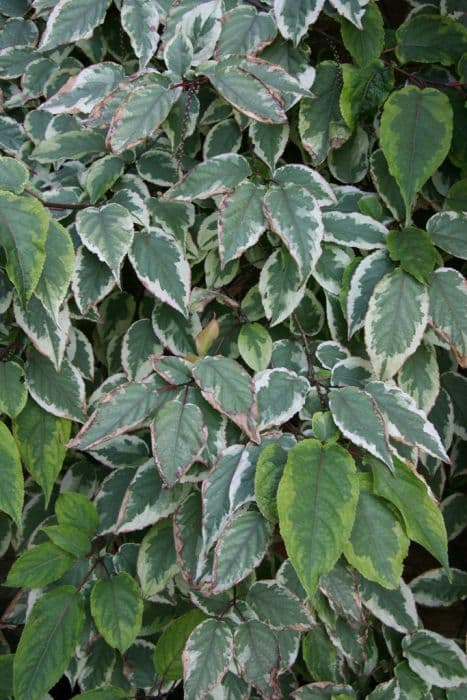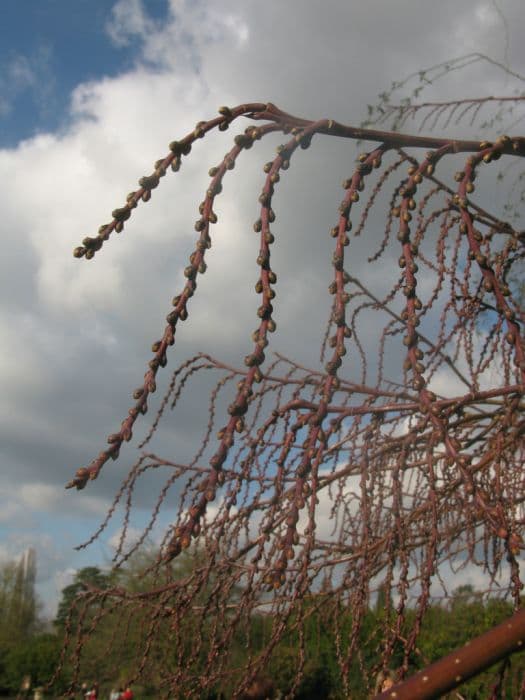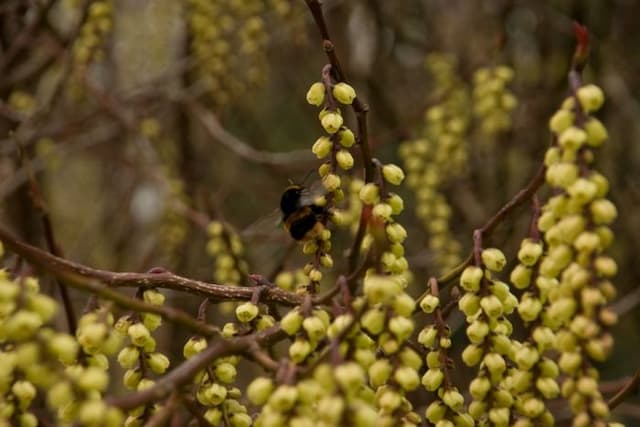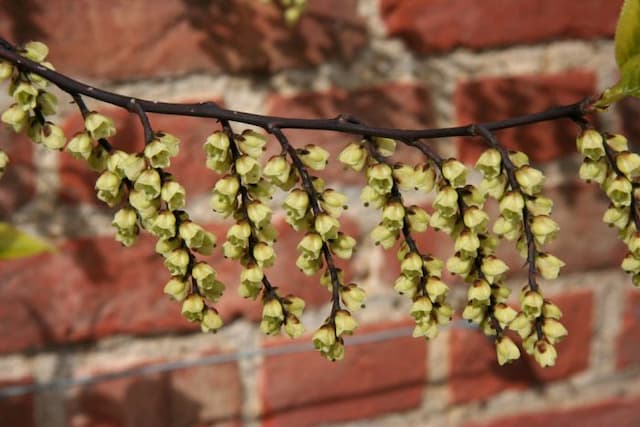Chinese Spiketail Stachyurus chinensis 'Celina'

ABOUT
The plant known as 'Celina' showcases an ornamental appeal throughout its structure. It boasts elongated, arching branches that gently weep, creating a graceful and flowing silhouette. The foliage is composed of oval-shaped leaves that exhibit a deep green hue, adding a lushness to the plant's overall appearance. What truly sets 'Celina' apart are its stunning flowers. These pendant blooms dangle in chains along the branches, infusing the plant with a touch of whimsy. Each flower cluster is composed of multiple delicate, bell-shaped flowers, which are a soft yellow color, providing a lovely contrast against the green leaves. After the flowering season, these blossoms give way to seed capsules that can also be quite attractive. The transition through the seasons brings a dynamic and evolving charm to 'Celina,' making it a captivating addition to any space where it blooms.
About this plant
 Names
NamesFamily
Stachyuraceae
Synonyms
Chinese Stachyurus, Celina Stachyurus
Common names
Stachyurus chinensis 'Celina'.
 Toxicity
ToxicityTo humans
The Chinese Stachyurus or more commonly known as Stachyurus chinensis 'Celina' is not widely recognized for having toxic properties that affect humans. However, not all potential reactions in every individual are documented, and it is generally a good practice to avoid ingesting parts of ornamental plants due to potential unknowns or individual sensitivities. If you suspect poisoning from any plant, it's important to seek professional medical advice or contact a poison control center immediately.
To pets
The Chinese Stachyurus, commonly referred to as Stachyurus chinensis 'Celina', is not commonly listed as a toxic plant to pets such as dogs and cats. Nonetheless, the ingestion of plant material by pets can sometimes cause gastrointestinal upset regardless of the plant's toxicity profile due to the pets' inability to digest certain plant materials. If your pet has ingested this plant and is showing symptoms of distress, consult with your veterinarian promptly.
 Characteristics
CharacteristicsLife cycle
Perennials
Foliage type
Deciduous
Color of leaves
Green
Flower color
Yellow
Height
6-10 feet (1.8-3 meters)
Spread
4-8 feet (1.2-2.4 meters)
Plant type
Shrub
Hardiness zones
6
Native area
China
Benefits
 General Benefits
General Benefits- Aesthetic Appeal: Chinese Stachyurus 'Celina' provides visual interest particularly in early spring when its pendant-like clusters of yellow flowers bloom before the foliage emerges.
- Seasonal Interest: It offers multi-seasonal interest with its flowers in the spring, lush green leaves in the summer, and purplish or reddish hues in the autumn foliage.
- Landscape Versatility: This plant can be used in a variety of landscape situations, including mixed borders, specimen planting, and woodland gardens.
- Wildlife Attraction: The flowers can attract pollinators such as bees and butterflies, beneficial for local ecosystems.
- Low Maintenance: Chinese Stachyurus 'Celina' is relatively easy to care for, requiring minimal pruning and maintenance once established.
 Medical Properties
Medical PropertiesThis plant is not used for medical purposes.
 Air-purifying Qualities
Air-purifying QualitiesThis plant is not specifically known for air purifying qualities.
 Other Uses
Other Uses- Wildlife Attractant: Stachyurus chinensis 'Celina' produces flowers that can attract pollinators like bees and butterflies, enhancing local biodiversity.
- Garden Specimen: With its unique pendant-like blooms, it can serve as a solitary specimen in a garden, drawing visual interest throughout the spring season.
- Floral Arrangements: Branches of Stachyurus chinensis 'Celina', with their attractive flowering spikes, can be cut and used in floral arrangements.
- Photography Subject: The plant's distinctive flowers make it an excellent subject for botanical photography and garden-inspired art projects.
- Educational Tool: It can be used in educational settings, such as botanical gardens, to illustrate plant growth and flowering patterns to students and visitors.
- Landscape Theme: The plant can be integrated as part of an Asian-themed garden, reflecting its natural origins and contributing to a harmonious landscape design.
- Windbreaks: When planted in groups, these shrubs can act as windbreaks, protecting more delicate plants in the garden.
- Bonsai Creation: Mature specimens may be cultivated as bonsai for enthusiasts looking to create miniature landscapes.
- Hedge Planting: It can be used in informal hedge plantings, offering a seasonal display that changes throughout the year.
- Garden Contrast: The distinctive form and early flowering time of Stachyurus chinensis 'Celina' provide a welcome contrast to the typical evergreens and perennials in a garden setting.
Interesting Facts
 Feng Shui
Feng ShuiThe Stachyurus is not used in Feng Shui practice.
 Zodiac Sign Compitability
Zodiac Sign CompitabilityThe Stachyurus is not used in astrology practice.
 Plant Symbolism
Plant Symbolism- Renewal: Stachyurus chinensis, commonly known as Chinese Stachyurus, typically blooms in early spring, symbolizing the renewal and rebirth that comes with the season.
- Transition: The plant's early blooming can also represent transition, as it marks the change from winter dormancy to vibrant spring growth.
- Hope: The Chinese Stachyurus' early flowers bring hope to a landscape still recovering from winter, symbolizing the promise of warmer days and new growth.
- Beauty in Simplicity: With its elegant yet understated flowers, the Chinese Stachyurus signifies the beauty that can be found in simplicity and the understated.
 Water
WaterThe Chinese Stachyurus prefers consistent soil moisture, and should be watered deeply once a week, allowing the top inch of soil to dry out between waterings. Water the plant with about 1 to 1.5 gallons, depending on the size of the shrub and weather conditions. During hot, dry spells, you may need to water twice a week to maintain moisture levels. However, in the winter and during periods of rainfall, reduce the frequency to prevent waterlogging.
 Light
LightThe Chinese Stachyurus thrives in dappled sunlight to partial shade. It performs best when sheltered from intense midday sun, which can scorch the leaves. Ideal locations include an east-facing or north-facing spot that receives morning light and afternoon shade, or beneath the canopy of larger trees that filter the sunlight.
 Temperature
TemperatureChinese Stachyurus is hardy and can withstand a temperature range from about 10 to 95 degrees Fahrenheit. The ideal temperature for promoting robust growth is between 60 to 80 degrees Fahrenheit. It is important to protect the plant from extreme temperatures in both ends of its tolerance spectrum to prevent damage to foliage and roots.
 Pruning
PruningPruning the Chinese Stachyurus should be done primarily to maintain shape and remove any dead or damaged branches. The best time for pruning is in late winter or early spring before new growth starts. Generally, this plant requires minimal pruning and it is only necessary to do so every two or three years to rejuvenate older plants.
 Cleaning
CleaningAs needed
 Soil
SoilThe Spike-tail prefers well-draining, humus-rich soil with a slightly acidic to neutral pH of about 5.5 to 7.0. A good mix would be a blend of garden soil, peat moss, perlite, and compost, ensuring it's fertile and has good moisture retention while also allowing excess water to drain away effectively.
 Repotting
RepottingThe Spike-tail typically needs to be repotted every 2 to 3 years. It grows relatively slowly, so frequent repotting is not necessary. Monitor the soil condition and root growth to determine the need for repotting, ensuring not to disturb the roots unduly during the process.
 Humidity & Misting
Humidity & MistingSpike-tail thrives best in moderate humidity levels, around 40-60%. Although it can tolerate lower humidity, maintaining this range will support healthier foliage and growth. Avoid placing it in excessively dry environments, which may necessitate the use of a humidifier or regular misting.
 Suitable locations
Suitable locationsIndoor
Position in bright, indirect light and ensure pot has drainage.
Outdoor
Plant in dappled shade, mulch well, protect from harsh winds.
Hardiness zone
6-9 USDA
 Life cycle
Life cycleStachyurus chinensis 'Celina', commonly known as Chinese Stachyurus, begins its life as a seed, which upon germination in suitable conditions, develops into a young seedling. The seedling grows into a juvenile plant, establishing a root system and producing its characteristic deciduous foliage. As it matures, the plant enters the vegetative stage, where it focuses on growth and photosynthesis, developing a woody structure and branching pattern typical of the species. The Chinese Stachyurus eventually reaches reproductive maturity, typically flowering in early spring with hanging racemes of yellow flowers before the leaves emerge. After pollination, flowers develop into fruit in the form of capsules containing seeds, which, once ripened, are dispersed to begin a new cycle. The plant enters a period of dormancy in the winter, shedding leaves to conserve energy until the next growing season.
 Propogation
PropogationPropogation time
Early spring
Propogation: The Chinese Stachyurus, known scientifically as Stachyurus chinensis 'Celina', is commonly propagated by semi-hardwood cuttings during the late summer. To undertake this method, one would select a healthy, non-flowering stem from the current year's growth. A cutting, about 4 to 6 inches long (approximately 10 to 15 cm), is made just below a node, and the lower leaves are removed. The cut end is then dipped in rooting hormone powder to encourage root development and planted in a well-draining potting mix. The cutting needs to be kept in a warm, humid environment, and consistently moist, until roots have established, which usually takes several weeks.




